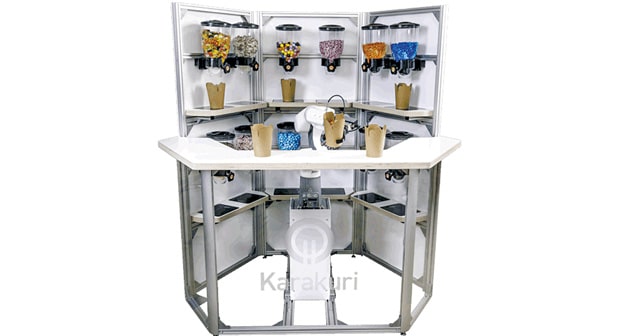- Contact Us
- +91-98111-55335
- [email protected]

AI-driven cobots in logistics and beyond
August 21, 2020
DIY: Turn Your Phone Into A Contactless Thermometer
August 21, 2020Bringing automation to the kitchen with robotics

Globally, more than enough food is produced to feed the entire human population, but world hunger is still an appalling problem in the modern world. One of the main reasons behind this is the wastage of food after harvest due to causes like improper packaging of meals or inadequate food storage systems. Overproduction of food is done to compensate for the wastage. But this requires more water and land, which leads to an excessive carbon footprint. In addition to this, a growing number of people are switching to healthier lifestyles.
These are some of the reasons that pushed Simon Watt and Barney Wragg along with Brent Hoberman to establish UK-based startup Karakuri two years ago. The company develops and installs intelligent robotic automation systems for restaurants, commercial kitchens, and the like. By adding machine learning (ML), optics, and sensors, the system is capable of producing personalised fresh meals with a focus on nutrition, calories, and quantities.
By tracking the required quantities, the data can be used by ML models to predict future requirements, which aids in streamlining the food supply chain and reduces food wastage. With automation, staff can also focus on more creative roles instead of regular, repetitive, and time-consuming manual tasks. The purpose is not to replace human workers but to help them in food preparation. This boosts productivity and increases customer satisfaction, including those with food allergies, which benefits businesses.
Their first off-the-shelf food preparation robot, DK-One (2100mm× 2400mm; 1,125kg), allows users to adjust their meals so as to fit their requirements based on the mass and temperature of individual ingredients. Typical output is one meal every ten seconds, assuming an average of 5.6 ingredients per box. With an average power consumption of 1500W and an IP44 IP rating, a maximum of 48 ingredients, including wet, dry, soft, or hard, can be dispensed per installation.
The economical alternative to DK-One is Marley (1700mm× 1750mm; 250kg), which is capable of providing customisation on a small scale. Not more than twelve ingredients can be dispensed into a biodegradable cup for each installation, with a typical meal output of one serving per thirty seconds. The average power consumption is only 400W.
In 2019, the startup raised £7million seed funding from Ocado Group, Firstminute Capital, Hoxton Ventures, and Taylor Brothers. The products can cater to a wide range of applications, including hospitals, ice cream parlours, cinemas, airports and transport hubs, stadiums and sports events, canteens and cafeterias, among others.
Due to the massive impact of Covid-19 on the hospitality industry, businesses have a huge focus on contactless delivery and maintaining proper hygiene. Consumers are hesitant to order food even in places where lockdown restrictions have been lifted. In such a situation, technology like robotics can aid in reviving the post-pandemic economy. Using food preparation robots like that from the startup is likely to become a preferred option due to the lower risk of contamination. Also, customers can interact with a restaurant’s menu via an app so that social distancing measures are followed.
—Ayushee Sharma
